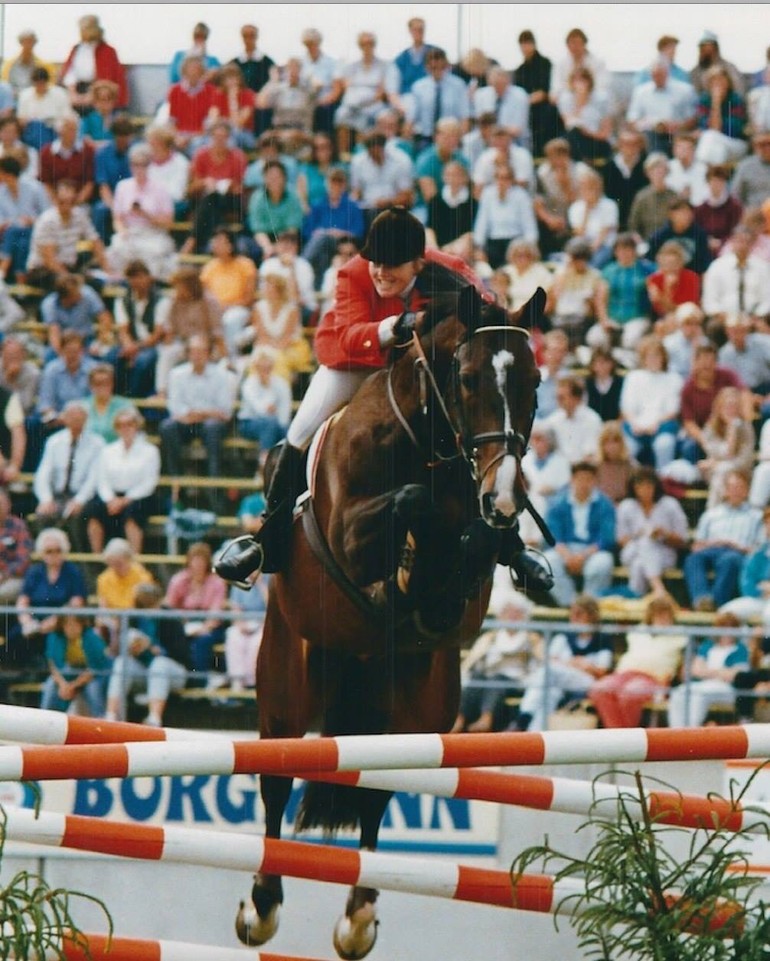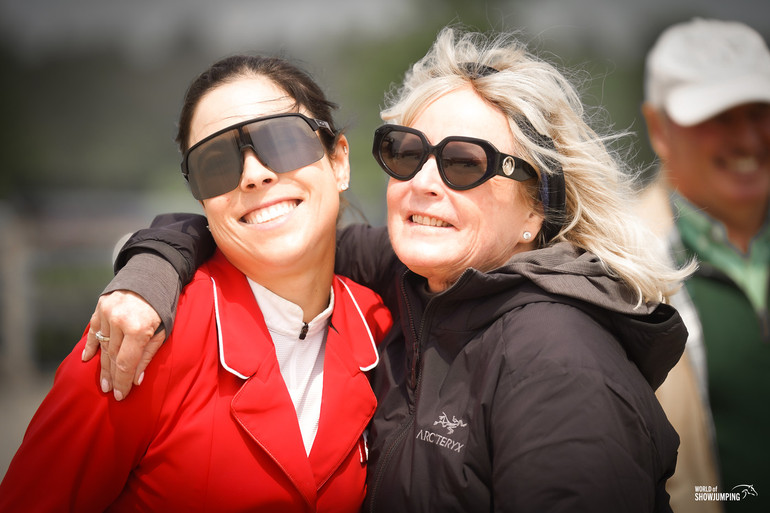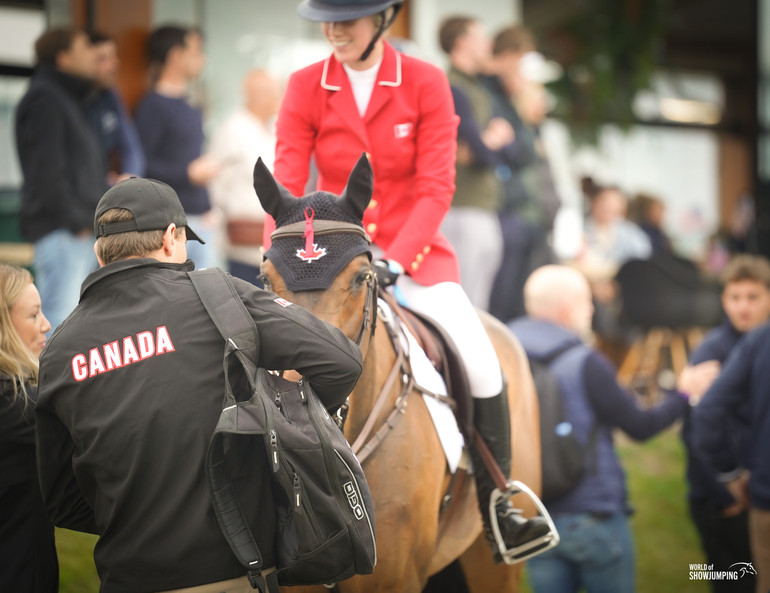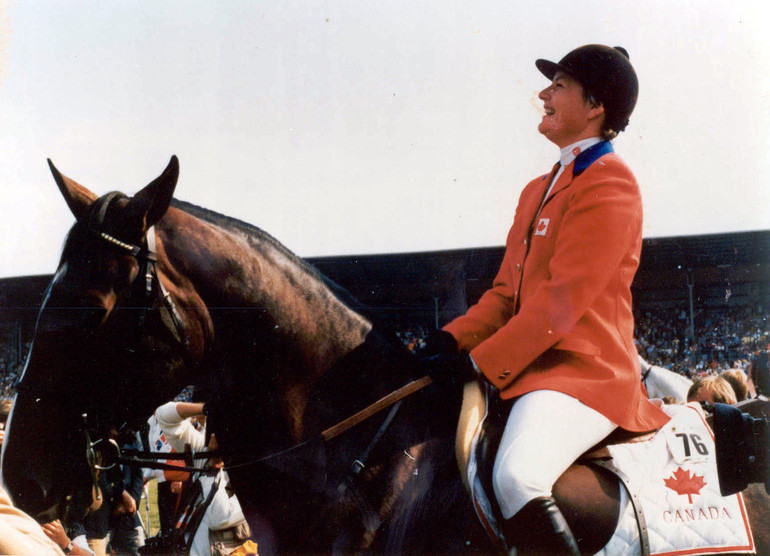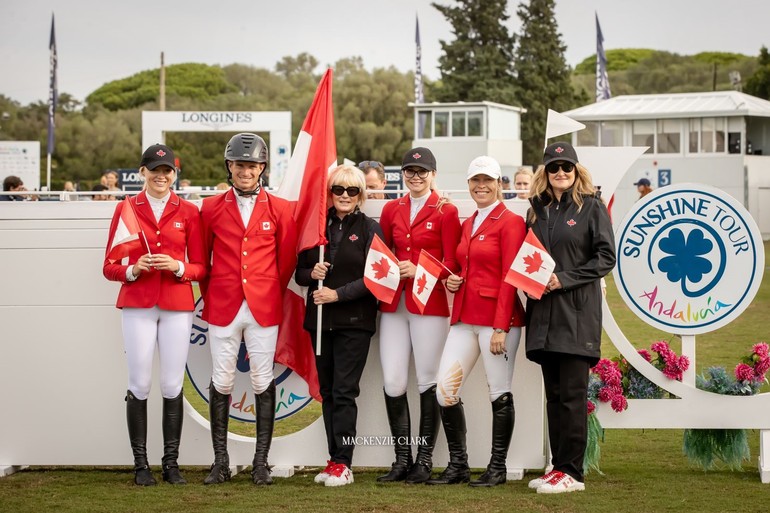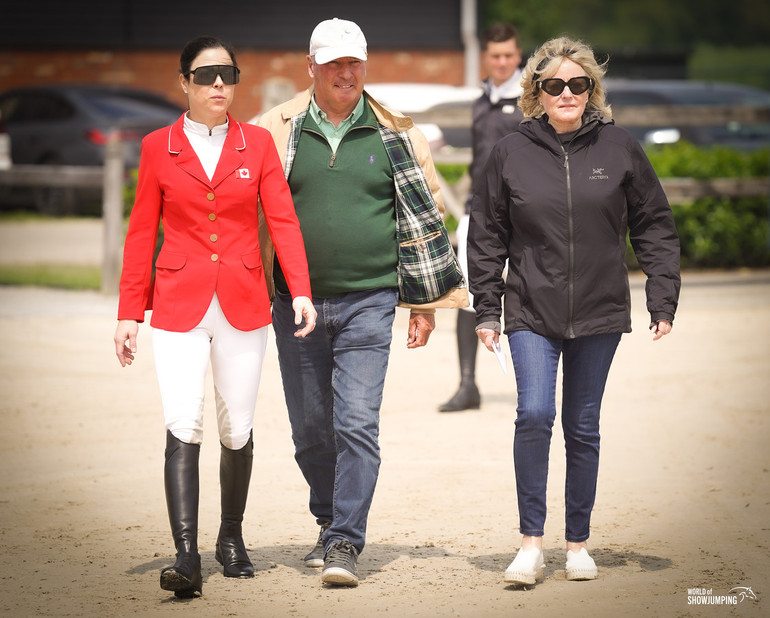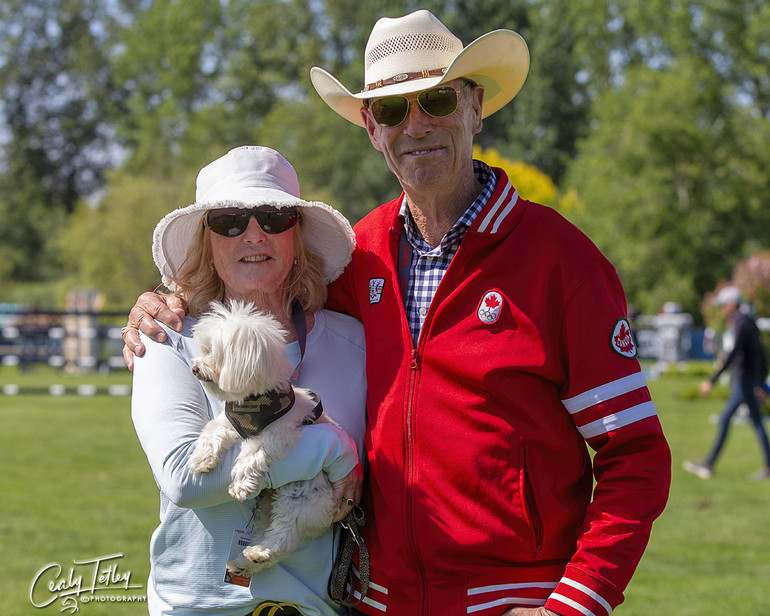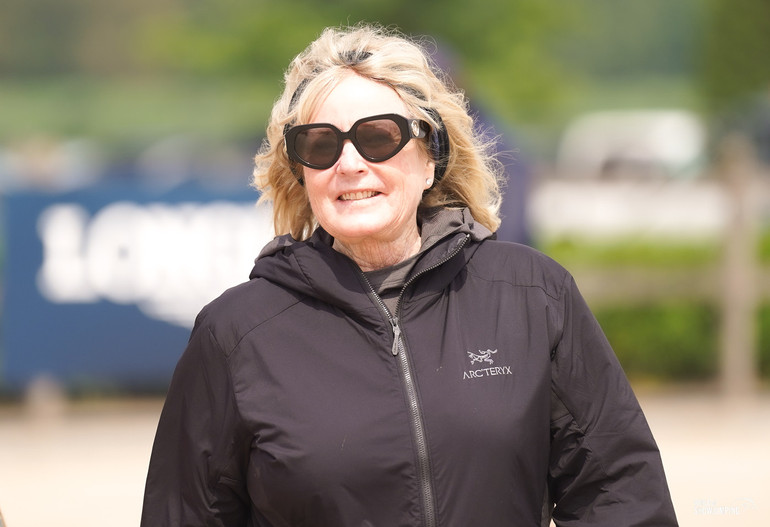 “Horsemanship, it is all-encompassing,” 1986 World Champion Gail Greenough says to WoSJ. “It's the love of the horse and the knowledge of the horse, the education and knowing your horse inside out. What are their habits, what's good for them? Every horse is different, and unless you spend time with them, you don't know what is right for them." Photo © Nanna Nieminen/WoSJ.
“Horsemanship, it is all-encompassing,” 1986 World Champion Gail Greenough says to WoSJ. “It's the love of the horse and the knowledge of the horse, the education and knowing your horse inside out. What are their habits, what's good for them? Every horse is different, and unless you spend time with them, you don't know what is right for them." Photo © Nanna Nieminen/WoSJ.
Text © World of Showjumping
“I just loved horses, pursued my passion and grew with the sport,” 1986 World Champion Gail Greenough tells World of Showjumping. “I didn't grow up as a second or third generation horse person. However, I always knew that I wanted to ride.”
Riding Mr T., Greenough was the first woman and the youngest rider to take the World Champion-title when she as a 26-year-old won with a score of zero at the 1986 FEI Jumping World Championship in Aachen, Germany. In the final four, she was up against legends: Pierre Durand (FRA) and Jappeloup, Conrad Homfeld (USA) and Abdullah as well as Nick Skelton (GBR) and Apollo, who had all won medals with their teams.
Going from a local pony club to being crowned World Champion in her twenties, Greenough soon switched her successful riding career to coaching. From the ground, the now 64-year-old has played a pivotal role in the Canadian showjumping team as one of the selectors.
Aachen 1986 and 2006 – how quickly can you find empathy?
Surprisingly, Greenough has returned to Aachen only once since her 1986-title. “I was there when Jos and Cumano won in 2006,” she tells. “When I won, it was me against the three guys and when Jos won, it was him against the three girls. It was interesting to watch them switching horses between them in the final four, the rotation which we don't have anymore. It's nerve wracking! You had to have a good feel for a horse pretty fast because you only had two minutes and two jumps. Obviously, it is more stressful on the horse than on the rider, which would be the negative. The positive would be that it really does exhibit the riders’ abilities and how quickly they can find their empathy with the horses. How quickly do they read their partner? What I loved about that era was how the final four differentiated the World Championship from any other championship.”
You had to have a good feel for a horse pretty fast because you only had two minutes and two jumps.
“I had to ride Jappeloup, Apollo and Abdullah,” Gail recalls about her own final rotation. “They were all very different horses. What I did is that I studied videos, and that was in the days before the internet! I went to the video truck and watched VHS videos of the horses. I likened them to horses that I had at home or had ridden in my past. I wanted to mentally get a feel for what I thought I was going to be sitting on without getting too many assumptions – because assumptions can be dangerous. I had four clean runs and Abdullah was the best horse with all the four riders. Conrad did a good job on Mr T., Pierre had him a little bit too bloody and Nick softened the reins too much; Mr T. liked a little feel. They were a little hit and miss here and there, but Conrad was the best one on him, I would say. However, he also knew Mr T. the best because he had seen us in North America.”
Leading up to final, Greenough was the only double clear in the Nations Cup. “I had a good week as far as weeks go; everything fell into place at the right time. Also, I had a great team of vets, blacksmiths and grooms; I had good people behind me. All the things were in place to set me and my horse up for success.”
Prior to Aachen, the World Cup Final in Gothenburg that same year was the only other championship Greenough had even ridden. “I think it worked for me and not against me, because my expectation was just to go and see what would happen,” she explains about the fact that sometimes, inexperience can be an advantage. “I believed in my horse and in our ability. Probably that worked to my advantage versus going in with the expectation that I was going to get a gold medal. I didn't have that pressure on me, same as in the final four; the boys had more pressure than I did.”
Coach, two-times survivor and a Mama Gail
“One of my regrets is that I did not have children; I sort of gave that up,” Gail says about her career. “I did that probably not out of choice, but I simply ran out of time. You're so involved in this sport, almost to the exclusion of everything else in your life. My hat goes off to Amy Millar, Meredith Michaels-Beerbaum and all the riding mums of the world. Doing both, the sport and having children, is not easy. By nature, when women have children that takes over, takes precedence – as it should. To manage both is very difficult. I'm Mama Gail to a lot of the girls in this sport now, that has been my nickname. I take pride in that, and I feel like that's a way to contribute as well.”
You're so involved in this sport, almost to the exclusion of everything else in your life.
Now a fulltime coach, Greenough already had a coaching business while she was riding. “Just because you were a great rider and had great success does not mean that you can also be a great coach,” she points out. “Those are two different skill sets. I think that there are great coaches that haven't been great riders but have a feel for what they see on the ground. I don't think it's completely necessary that you've gone to the top of the sport to be a great coach. I've seen great riders that really aren't that good on the ground and I've seen really good people on the ground that never were at the top of the sport. I would say it is more unusual to be successful at both; to be a rider and a coach at the top of the sport.”
“I decided quite a few years ago to hone my coaching skills,” she continues. “After the World Championship in 1986, I worked together with Ian Millar for a few years and that catapulted my love for coaching. For many years, I had a large business in Canada and I've since shut that down. Now, I work with elite athletes and I am also a selector for the Canadian team and help Ian with the chef d’equipe duties.”
“I had a few turn-around moments in my life that made me prioritize differently and made me choose coaching over riding. In 2008, I had breast cancer, which I survived and about eight years ago, I had another severe cancer, stage three going to stage four. When you go through something like that, it sort of makes you reprioritize your life, it makes every moment count. What doesn't kill you makes you stronger and I'm a survivor – twice.”
All the cogs in the wheel
In her current role as a coach and team selector, Greenough utilizes her own experiences. “The biggest lesson from my riding career was developing the mental tenacity, the toughness,” she says. “You need to have a strong mind to do this, and you need to be smart. And then of course you have to have great riding ability, but you also have to know how to manage a wonderful team behind you. There are so many cogs in the wheel and the wheel has to stay pretty steady. If you miss a cog, you have a bumpy wheel, which is not good. You have to excel in getting all the components right.”
You have to excel in getting all the components right.
“I've probably been coaching longer than I've been a rider and I use all of my experience, but at the same time, I also keep an open mind,” she continues. “Going to different venues and talking to different people, watching everyone from how they're warming up to the equipment they are using – it is such an interesting sport. There are slight differences between Europe and North America and you sort of blend it all together for success. I take each horse-and-rider combination as one athlete and work on them together versus one rider and one horse. One rider could ride six different horses and might have to do something different with each of them. It's the unity between the horse and the rider that I look at, that would be my main focus. Right now, I'm working with elite athletes. They are good athletes and they know how to ride, so my role is just about small little tweaks, minute details that could make a difference.”
“That has been fantastic, I applaud that, absolutely,” Gail says about grooms getting more acknowledged for the important part that they play. “They're a vital part; that's a cog in the wheel. If you don't have good people looking after your horse and supporting you, then you have a bit of a flat tire. I think anybody with a head on their shoulders understands the importance of grooms. And those who don't, shouldn't be in this sport.”
Horsemanship is all-encompassing
Greenough believes that in order to be successful on the world stage, your horse has to be your best friend and ready to back you up in the fight. “That's the biggest component; our sport is about a partnership and you have to fight together and celebrate together,” she says. “Horses have egos just like people do. The partnerships I had with my horses were special – very special – and each one of them was different, as human relationships are as well. I don't think you get to the top knowing anything different. And if you are at this level and you only show up, get on and off the horse and walk away, you're not going to be doing this for long.”
What is the biggest commodity in this world? Time. And spending that on your horses is horsemanship.
“Horsemanship, it is all-encompassing,” she continues. “It's the love of the horse and the knowledge of the horse, the education and knowing your horse inside out. What are their habits, what's good for them? Every horse is different, and unless you spend time with them, you don't know what is right for them. What is the biggest commodity in this world? Time. And spending that on your horses is horsemanship.”
“You have to be very open minded and willing to discuss things with everybody around you, don't have a shut door,” Gail points out about the importance of staying curious. “I think in North America, trainers can get a little ‘my way or the highway’ and protect their clients from talking to anybody else. I see that more in North America than in Europe; it's more collaborative in Europe, which I like a lot. In Europe, you have so many competitions within such a small area. There are so many choices, and the development of young horses is much easier. I think the sport works much better here. Canada is huge, geographically. We're crossing oceans and putting our operation on the road to Florida in the winter, where we'll spend four or five months. We have a home in the south and a home in the north.”
Team Canada
As a selector for the Canadian jumping team, Greenough is very happy with the form her horse-and-rider combinations are currently showing. “Our athletes at the top are strong. Canada might be small in numbers, but we are mighty, and I have my hopes for the Olympic Games. However, there are many strong countries so it will be tough – as always.”
The situation with the Nations Cups is difficult now, when the Longines League of Nations is only for the top few.
“The Longines EEF Nations Cups that we have been doing in Europe have been great for our development, and we would like to get into more,” she continues. “We have a lot of athletes that base themselves in Europe. It has helped with our depth because here, they can go to all these different competitions and collaborate with so many different people – it's fantastic. The situation with the Nations Cups is difficult now, when the Longines League of Nations is only for the top few. For most riders, riding in a Nations Cups for their country is the highlight of their career. It's such a different feel than doing a single Grand Prix class. As a country, we would like to go to more CSIO events, and I think many other national federations are in a similar position.”
“In order for us to come to these Nation Cups, the funding is crucial,” Gail points out. “This is an expensive sport, so I'd like to thank those that support us. And kudos to our Canadian riders here in Europe that are trying to develop themselves. It's not an easy life. I'd like to thank them for being here as well as the funders; we can't do it without them. Back home we have our major Chef Ian Millar, our Captain. We are very grateful to have him. He's done it all and he is a great coach, we are so fortunate that he's Canadian.”
Those who are passionate and clever will find a way
“Sure enough, we cannot deny the fact that this is an expensive sport. However, those who are passionate and clever enough will find a way, they will figure it out,” Gail says when asked how she sees the discussion about the growing costs and the argument of showjumping possibly turning into an elite sport for a chosen few. “I believe that it is still possible to make it to the top without being wealthy. There are many examples of that. I think there is just a lot more attention being paid to those that have more means. If you looked at the demographics, there's probably more people with less money than more money. If you're passionate, clever and a good enough rider, you will make it work.”
Anyone successful in this sport has to be a good rider, first of all, and secondly, love their horses.
“On the other hand, if somebody has a lot of money and they acquire a string of very good horses, if they spend time to become real horse people, and end up successful, are they judged inappropriately?” Gail asks. “This sport is expensive. However, there are several ways to do it; with sponsorship, owners, syndicates, groups, coaching your way through it. It takes money for sure, but I think we need to be careful not to judge somebody who is successful and happens to be wealthy. It's not the money that got them there; anyone successful in this sport has to be a good rider, first of all, and secondly, love their horses.”
“If I started now, I would have to be the clever person finding the money,” Gail reflects on the evolution of the sport since her riding days. “The sport has gotten a lot more expensive since I started. I was fortunate and got lucky with some purchases of horses. I bought horses, produced and sold them and that way made it work for myself. The courses have changed as well, they are more technical. You still have to be brave but it's all a lot faster, and the breeding has made the horses much quicker as well. However, Mr T., who I won the World Championships on, would have been good today. He was a modern type; I didn't know it back then, but he would still be competitive today. The sport has changed a lot and we have to keep up with the times.”
Focus on the horse and be empathetic to the actual players
“Well, I don't have a crystal ball, but currently, there is a lot of discussion about the welfare of the horses and education,” Gail says about the future. “I would hope that we continue in that vein and that riders continue to educate themselves. I don't know how much more difficult we can make the actual competition; the course designers are fantastic. My hope is that we don't get too isolated as a sport. It's a bigger sport in Europe to the public whereas in North America it's like ‘you do what, what sport is that?’ It's more of a way of life in Europe; you drive around and everybody has a horse in their backyard. It is more agriculturally based than in Canada where everything is more segregated.”
Horses like their job and they get better care than most people do. I'd like to see more focus on that.
The threat of being excluded from the Olympic Games as a sport is a lens Greenough does not want to look through. “It would be tragic; it would further isolate our sport. As a sport, we have gone from the individual showjumping final being held in the stadium right before the closing ceremony, from being such a highlighted event, to now having doubts on whether we will be included in the future. I understand that it's expensive to organize, but my love of the sport hopes we stay in. I'd like everybody to continue on focusing on the horse and what a magnificent animal they are and how much they actually enjoy their part in the sport. As riders, we know when a horse doesn't enjoy it and we know when a horse loves it. The outside world needs to understand that if a horse doesn't want to jump, they are not going to jump and there is nothing we can do about it. Horses like their job and they get better care than most people do. I'd like to see more focus on that. Maybe I'm looking through rose-coloured glasses, but I think that the welfare of the horses has gotten better: There is more understanding, more knowledge, more education.”
“The welfare of the horses is the centre to our success,” Greenough concludes. “And at the end of the day, it takes a horse person to make the rules. I understand that the governance of the sport is difficult and you can't please everybody. However, those making the calls should be more empathetic to the actual players in the arena and how it affects them. They should walk a mile in our shoes.”
12.6.2024 No reproduction of any of the content in this article will be accepted without a written permission, all rights reserved © World of Showjumping.com. If copyright violations occur, a penalty fee will apply.



